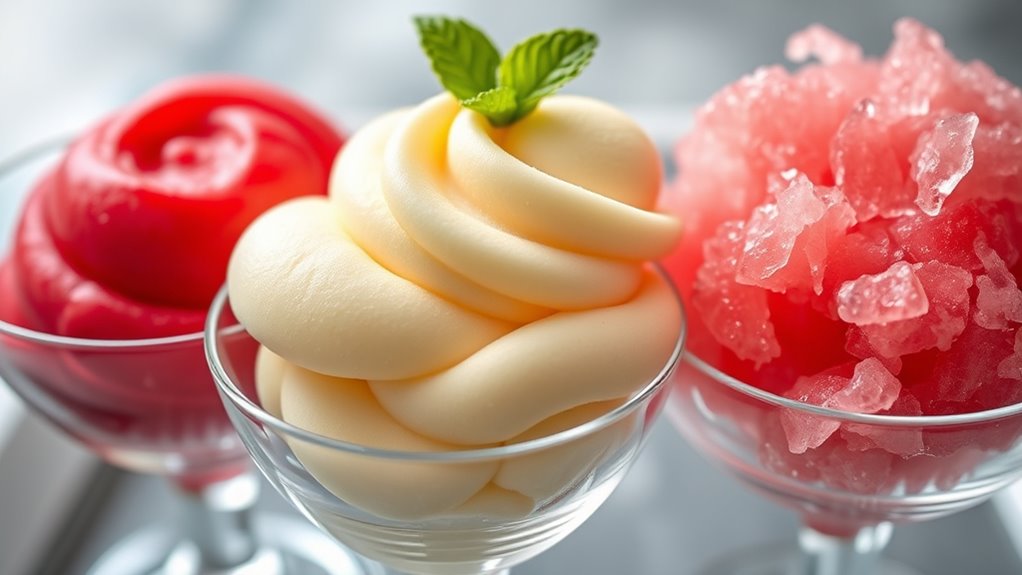Frozen delights like sorbet, semifreddo, and granita each offer a unique icy experience. Sorbet emphasizes pure fruit flavors with a smooth, icy texture, while semifreddo blends a mousse-like creaminess with chill. Granita provides a coarse, crystalline texture, scraped into icy shards. Understanding their ingredients and textures helps you choose the perfect treat to cool off. Keep exploring, and you’ll discover even more about these classic frozen favorites.
Key Takeaways
- Sorbet is a dairy-free frozen dessert made from fruit juice or puree, emphasizing pure fruit flavor with an icy texture.
- Granita is a semi-frozen, crystalline dessert scraped into a granular, slushy texture, originating from Sicily.
- Semifreddo is an Italian frozen dessert with a creamy, mousse-like texture, often containing egg yolks, sugar, and whipped cream.
- All three are considered frozen delights because they provide refreshing, chilled treats with distinct textures and flavors.
- The main difference lies in ingredients and texture: sorbet (fruit-only), granita (coarse, scraped ice), semifreddo (creamy and mousse-like).

Have you ever wondered why frozen treats are such a popular way to beat the heat? It’s because they provide instant relief and a burst of invigorating flavor. When it comes to frozen delights, many people get confused about what exactly makes a treat a sorbet, sherbet, or granita. One common question is about sorbet vs. sherbet, which often seem similar but have key differences. Sorbet is typically made from fruit juice or puree, combined with sugar and sometimes a little water, then churned to create a smooth, icy texture. Sherbet, on the other hand, includes a small amount of dairy, like milk or buttermilk, which gives it a creamier feel without the richness of ice cream. The addition of dairy also influences the flavor and texture, making sherbet slightly richer but still light.
Understanding these differences ties back to the historical origins of frozen desserts. Frozen treats have been around for centuries, with their roots tracing back to ancient Persia and the Middle East, where snow and ice were combined with fruit juices and honey. In China, around 200 BC, a mixture of snow and fruit or rice was enjoyed as a cooling delicacy. The concept spread to Europe during the Middle Ages, where aristocrats enjoyed icy desserts flavored with fruits and herbs, often using snow stored in underground chambers. Sherbet, originating from the Arabic word ‘sharbat,’ evolved as a fruit-flavored icy treat with a hint of dairy, becoming popular in Europe in the 17th century. Sorbet, which emphasizes fruit alone, gained popularity later, especially as an elegant, dairy-free option. These early frozen desserts reflected luxury and innovation, often reserved for the wealthy due to the difficulty of preserving ice and snow in warmer climates.
Today, frozen desserts like sorbet, sherbet, and granita continue to evolve but still draw from their rich history. Granita, originating from Sicily, is a semi-frozen, textured ice that’s scraped with a fork, offering a more granular experience compared to the smoothness of sorbet or sherbet. Each has its own appeal, but what makes them all stand out is their ability to provide a quick, flavorful escape from the heat. Whether you prefer the pure fruit intensity of sorbet, the creamy hint of dairy in sherbet, or the icy texture of granita, these frozen delights are rooted in centuries of tradition. They remind us that a simple combination of water, fruit, and sugar can create something truly delightful to cool down and satisfy your sweet tooth.
Frequently Asked Questions
What Are the Origins of Sorbet, Semifreddo, and Granita?
You might wonder about the history origins of frozen treats, which have rich cultural influences. Sorbet, semifreddo, and granita each have unique roots—Sorbet traces back to ancient Persia, while semifreddo was popularized in Italy. Granita originated in Sicily, reflecting Mediterranean flavors. These desserts evolved through centuries, blending local ingredients and traditions, creating the diverse frozen delights we enjoy today. Their history showcases a fascinating mix of cultural influences shaping sweet icy treats.
Can Frozen Desserts Be Made Vegan or Dairy-Free?
You can definitely make frozen desserts vegan or dairy-free. Just use vegan substitutions like coconut milk, almond milk, or soy-based products instead of dairy. These dairy-free options still give you creamy, delicious treats. With a little creativity, you can enjoy a variety of frozen delights without animal products, ensuring everyone can indulge. So, yes, making vegan or dairy-free frozen desserts is easy and tasty!
How Do Texture and Consistency Differ Among These Treats?
When comparing textures and consistency variations, you notice that some frozen treats are smooth and creamy, while others are icy and granular. You’ll find that texture comparison reveals differences in mouthfeel—some are dense and rich, like semifreddo, while others, like granita, are coarse and invigorating. These variations depend on ingredients and preparation methods, giving each treat a unique consistency that appeals to different preferences.
What Are Common Flavor Pairings for Each Frozen Delight?
You crave invigorating, vibrant flavors that awaken your senses. You might pair fruit combinations like berry and citrus or tropical fruits with mint, basil, or rosemary for herbal infusions. These flavor pairings brighten each bite and create delightful contrasts. Whether you prefer a smooth, creamy semifreddo or a icy granita, combining sweet fruits with aromatic herbs adds depth and complexity, making every frozen treat an irresistible celebration of taste.
How Should I Store and Serve These Frozen Desserts?
When storing frozen desserts, you should keep them in an airtight container to prevent freezer burn and maintain freshness. For serving suggestions, let them sit at room temperature for a few minutes to soften slightly, making them easier to scoop or slice. Make certain your freezer is set to the right temperature, around 0°F, and always store leftovers promptly. Following these storage tips guarantees your frozen treats stay delicious and enjoyable.
Conclusion
Now that you know the differences between sorbet, semifreddo, and granita, you can confidently choose your frozen treat. Did you know that the global frozen dessert market is expected to reach $22 billion by 2027? So next time you’re craving something cold and sweet, you’ll appreciate the distinctive textures and flavors each offers. Whether it’s a invigorating granita or a creamy semifreddo, these delights are sure to satisfy your summer cravings.









